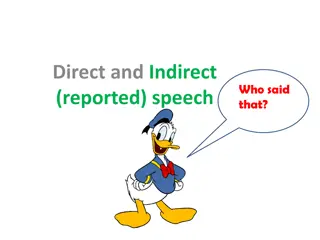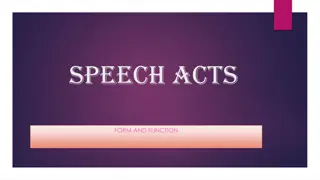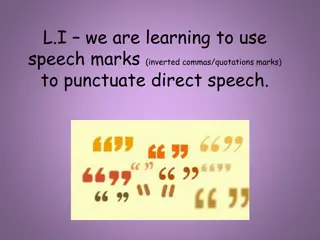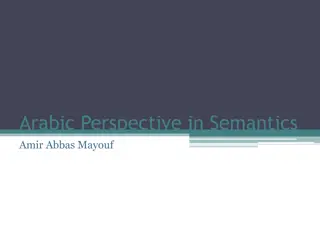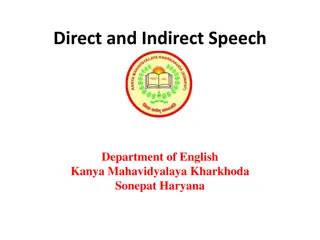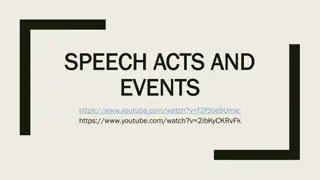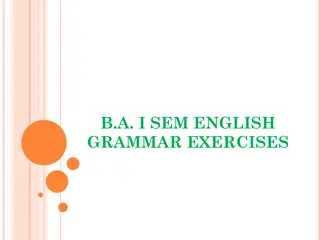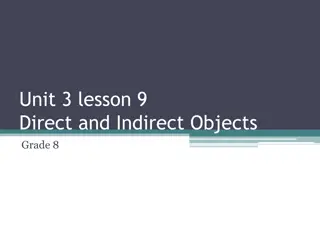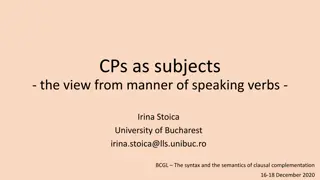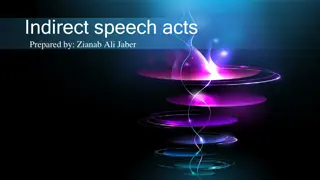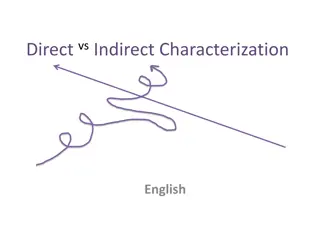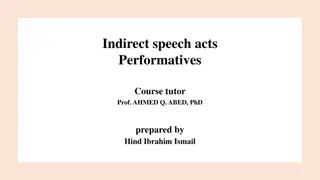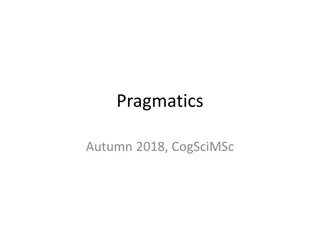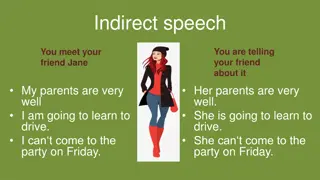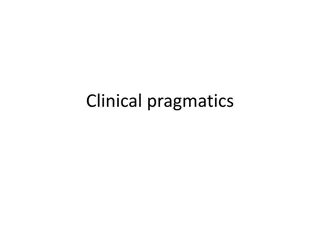Understanding Indirect Speech Acts in Semantics
Speech acts can be direct or indirect, with indirect speech acts relying on implicature rather than literal meaning. This concept can lead to confusion, especially in cross-cultural communication. Explore the theories of J.L. Austin and John Searle regarding speech acts and performative utterances, and practice identifying performative and constative utterances.
Download Presentation

Please find below an Image/Link to download the presentation.
The content on the website is provided AS IS for your information and personal use only. It may not be sold, licensed, or shared on other websites without obtaining consent from the author. Download presentation by click this link. If you encounter any issues during the download, it is possible that the publisher has removed the file from their server.
E N D
Presentation Transcript
SEMANTICS Indirect Speech Acts Presented By : Haider M. Alwan Course Touter: Prof. Ahmed Q. Abed
INTRODUCTION We will be talking about Speech Acts and specifically Indirect Speech Acts. Explaining what it is and giving few examples about it and its types.
INDIRECT SPEECH ACTS A speech act is an action that speakers perform by speaking: offering thanks, greetings, invitations, making requests, giving orders, etc. A direct speech act is one that is accomplished by the literal meaning of the words that are spoken. An indirect speech act is one that is accomplished by implicature. An indirect speech act can sometimes lead to confusions or mix ups, such mix ups are especially characteristic of cross-cultural communication. For this reason, indirect speech acts are a major focus of research in the areas of applied linguistics and second language acquisition. They also constitute a potential challenge for translation.
Asummary of J.L. Austins theory of speech acts, begins by identifying and analyzing a previously unrecognized class of utterances which he calls performatives. He then generalizes his account of performatives to apply to all speech acts. Searle s theory of indirect speech acts. Searle builds on Austin s theory, with certain modifications, and goes on to propose answers to two fundamental questions: How do hearers recognize indirect speech acts? (i.e., how do they know that the intended speech act is not the one expressed by the literal meaning of the words spoken). And having done so, how do they correctly identify the intended speech act? An answer to these questions is the recognition that indirect speech acts are a special type of conversational implicature.
PERFORMATIVES A PERFORMATIVE utterance is one that actually describes the act that it performs, i.e. it PERFORMS some act and SIMULTANEOUSLY DESCRIBES that act. I promise to repay you tomorrow is performative because in saying it the speaker actually does what the utterance describes, i.e. he promises to repay the hearer the next day. That is, the utterance both describes and is a promise. A CONSTATIVE utterance is one which makes an ASSERTION (i.e. it is often the utterance of a declarative sentence) but is NOT performative. I m trying to get this box open with a screwdriver is a constative utterance, because it makes an assertion about a particular state of affairs, but is not performative, i.e. the utterance does not simultaneously describe and perform the same act.
PRACTICE Are the following utterances performative (P) or constative (C)? (1) I name this ship Hibernia P / C (2) I believe in the dictatorship of the Proletariat P / C (3) I admit I was hasty P / C (4) I think I was wrong P / C (5) I hereby inform you that you are sacked P / C (6) I give you supper every night P / C
PRACTICE Are the following utterances performative (P) or constative (C)? (PAct of naming) (1) I name this ship Hibernia (C Only describes belief) (2) I believe in the dictatorship of the Proletariat (PAct of admission) (3) I admit I was hasty (C Only describes mental state) (4) I think I was wrong (PAct of informing) (5) I hereby inform you that you are sacked (C Only describes a state of affairs) (6) I give you supper every night
In Chapter 3 we cited the definition of sentence meaning repeated here: To know the meaning of a [declarative] sentence is to know what the world would have to be like for the sentence to be true. J.L. Austin, in a 1955 series of lectures at Harvard University, called attention to a class of declarative sentences which cannot be assigned a truth value, because they do not make any claim about the state of the world. Some examples are presented: a. I do (sc. take this woman to be my lawful wedded wife) as uttered in the course of the marriage ceremony. b. I name this ship the Queen Elizabeth as uttered when smashing the bottle against the stem. c. I bet you sixpence it will rain tomorrow.
Austin pointed out that when someone says I now pronounce you man and wife or I hereby declare this meeting adjourned, the speaker is not describing something, but doing something. The speaker is not making a claim about the world, but rather changing the world. For this reason, it doesn t make sense to ask whether these statements are true or false. It does, however, make sense to ask whether the person s action was successful or appropriate. Was the speaker licensed to perform a marriage ceremony at that time and place. Austin refers to the act which the speaker intends to perform by speaking as the illocutionary force of the utterance. Speech act and illocution will here be used synonymously.
EXAMPLES Can you please be quiet for a second? Locutionary level: asking if you are capable of not making noise. Illocutionary level: implying that I can barely stand your behaviour. Perlocutionary level: I want / expect you to be silent. Wouldn't you want to be like that? Locutionary level: asking for your opinion about a specific possibility / condition. Illocutionary level: implying that that possibility / condition is better than yours. Perlocutionary level: I expect you to agree with me that you should change.
Austin says, we need to identify the conditions under which the performative speech act will be felicitous, i.e. successful, valid, and appropriate. He identifies the following kinds of Felicity Conditions: (A.1) There must exist an accepted conventional procedure having a certain conventional effect, that procedure to include the uttering of certain words by certain persons in certain circumstances, and further, (A.2) The particular persons and circumstances in a given case must be appropriate for the invocations of the particular procedure invoked. (B.1) The procedure must be executed by all participants both correctly And (B.2) completely.
(C.1) Where, as often, the procedure is designed for use by persons having certain thoughts or feelings, or for the inauguration of certain consequential conduct on the part of any participant, then a person participating in and so invoking the procedure must in fact have those thoughts or feelings, and the participants must intend so to conduct themselves, and further (C.2) must actually so conduct themselves subsequently. Austin referred to violations of conditions A B as misfires; if these conditions are not fulfilled, then the intended acts are not successfully performed or are invalid. Violations of C Austin called abuses. If this condition is violated, the speech act is still performed and would be considered valid, but it is done insincerely or inappropriately. For example, if someone says I promise to return this book by Sunday, but has no intention of doing so, the utterance still counts as a promise; but it is an insincere promise, a promise which the speaker intends to break.
Performatives can be distinguished from normal declarative sentences by the following special features: Properties of explicit performatives: They always occur in indicative mood and simple present tense, with a non-habitual interpretation. They frequently contain a performative verb, i.e. a verb which can be used either to describe or to perform the intended speech act (e.g. sentence, declare, confer, invite, request, order, accuse, etc.). Performative clauses normally occur in active voice with a first person subject, but passive voice with second or third person subject is possible with certain verbs; Passengers are requested not to talk to the driver while the bus is moving. . Performatives can optionally be modified by the performative adverb hereby; this adverb cannot be used with non-performative statements. You are hereby sentenced to 10 years in prison. .
Furthermore we will refer to utterances which function as paraphrases of explicit performatives but lack the features listed above as implicit performatives. The concept of Felicity Conditions is useful in other contexts as well. For example, it would be very odd for someone to say The cat is on the mat, but I do not believe that it is. Austin suggests that this statement is not a logical contradiction but rather a violation of the Felicity Conditions for statements. One of the Felicity Conditions would be that a person should not make a statement which he knows or believes to be false (essentially equivalent to Grice s maxim of Quality).
It is just as outrageous to make a statement and then explicitly deny that you believe it, as it is to make a promise and then explicitly deny that you intend to carry it out (I promise that I shall be there, but I haven t the least intention of being there). We might refer to such an utterance as a pragmatic contradiction. Austin may have been the first to suggest that presupposition failure is a pragmatic issue (an infelicity), and not purely semantic.



